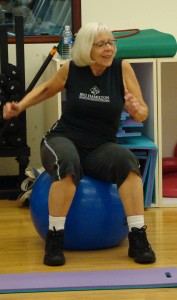by Michelle Sutton-Kerchner
Every 68 seconds, someone in the United States develops Alzheimer’s disease. Currently, 5.4 million people suffer it. There isn’t a cure or treatment. Yet, the worst response is to sit and worry about it. Take action …
Memory loss, behavioral issues, and personality changes are a few of the most common ways we lose a loved one to Alzheimer’s. Today’s longer life expectancy comes with an unfortunate increased incidence of Alzheimer’s patients. By the year 2050, 16 million people are expected to be affected.
In addition to debilitating effects on the Alzheimer’s victims and their loved ones, the disease has an incredible impact on healthcare costs. Those with Alzheimer’s and other forms of dementia have Medicare costs three times higher, and Medicaid costs 19 times higher, than their peers without such conditions. Whether on a personal or financial level, we all feel the impact of this disease at some point.
Although there isn’t a cure, you can take a proactive approach to your brain’s health. Treat it as a muscle and it will respond.
The Glycogen Factor
 A 2012 study out of Japan, published in the Journal of Applied Psychology, focuses on pre- and post-exercise glycogen levels. Glycogen is a polysaccharide of glucose chains. It stores energy that is a critical source for neurons and muscles. The body uses it as needed. During exercise, much of this storage is spent. But! An action called supercompensation restores glycogen levels 24 hours after exercise. Supercompensation elevates glycogen above pre-exercise levels; hence, its name.
A 2012 study out of Japan, published in the Journal of Applied Psychology, focuses on pre- and post-exercise glycogen levels. Glycogen is a polysaccharide of glucose chains. It stores energy that is a critical source for neurons and muscles. The body uses it as needed. During exercise, much of this storage is spent. But! An action called supercompensation restores glycogen levels 24 hours after exercise. Supercompensation elevates glycogen above pre-exercise levels; hence, its name.
The new study from Japan indicates supercompensation benefits the brain, as well as muscles. Glycogen levels were monitored in five different brain areas of rats, which have corresponding areas with the human brain. Glycogen decreased during exercise. After exercise, it increased to a level significantly higher than pre-exercise levels and lasted longer.
A group of rats trained to exercise regularly was compared to a sedentary group. The exercising rats had higher levels of glycogen in two areas of the brain. Further proof that exercise can improve the brain. Additional motivation to work out: If a rat can be trained to exercise, what excuse does that leave us?
The increased energy in the brain improves mental alertness and stimulates the brain to adapt to new challenges. If you are starved for good ideas or a solution to a dilemma, sweat the answer out of yourself.
How Does This Relate to Alzheimer’s?
Energizing the brain through exercise also plays a role in Alzheimer’s prevention. Studies suggest daily physical exercise — in all age groups– may reduce the risk of Alzheimer’s and cognitive decline. A study published in the medical journal Neurology (April 18, 2012) followed 716 people with an average age of 82 years. Participants continuously wore an actigraph (monitoring device) on their non-dominant wrist for 10 days. The study determined:
- People in the bottom 10 percent of daily physical activity were more than twice as likely to develop Alzheimer’s disease as people in the top 10 percent of daily activity.
- People in the bottom 10 percent of intensity of physical activity were almost three times as likely to develop Alzheimer’s disease as people in the top 10 percent of intensity of physical activity.

Considering the actigraph was worn on the wrist, activity beyond formal exercise was also tracked. The actigraph allowed more objective monitoring than reliance on self-reporting, where the definition of activity is subjective and details may be forgotten. Researchers followed participants’ daily activities, such as kitchen chores, laundry, cleaning, wheelchair use, card playing, and knitting. All were associated with a lower risk of Alzheimer’s. Annual cognitive tests were administered over the four-year span of this study.
The elderly population can enjoy these tasks, along with a decreased risk of cognitive impairment, with a little effort. This study proves movement, at any age and in a variety of forms, is beneficial. Those beyond age 80 can still benefit from an active lifestyle. Efforts to this effect are merited and should be supported. They do not incur costs, require minimal exertion, and do not produce side-effects. Although not a cure, the results are too impressive to discount.
Additional Ways Exercise Helps
Obesity and cholesterol levels are also considered risk factors for Alzheimer’s. Some types of dementia are caused by the same process of damage to small blood vessels in the brain that causes heart and peripheral vascular disease.
A 2011 study performed by Swedish researchers, published in Neurology, followed 8,534 twins over age 65 years. Thirty percent of participants were noted as overweight or obese. The result:
- The risk of dementia was almost double in those who were overweight versus those of normal weight.
- Those who were obese had almost a fourfold increase in risk.
Earlier studies specify those who carry weight in the belly area as higher risk for developing Alzheimer’s and other forms of dementia.

Start now. Your body’s present condition is the foundation of your future.
Although physical activity of any type is helpful in the late decades, train your body today for your future. It won’t have to be all Bingo and clothes-folding activities when you’re a great-grandparent. You’ll be capable of increased mobility, even if only a simple walk on the beach with friends or a float in the pool.
Exercise intensity isn’t as critical as an ongoing commitment to cardio fitness. To reduce risk of Alzheimer’s, healthcare experts suggest cycling, aquatics, and Group Fitness classes aerobic in nature. Focus on strengthening the core to reduce abdominal fat. Get cholesterol under control. (For exercises and guidance, see “Cholesterol: Don’t Fear It, Face It,” at F&W News, May 16, 2012.)
Quality studies over the past decade prove the link between a healthy weight and reduced incidents of Alzheimer’s and dementia. It parallels the same link for  lowering blood pressure, diabetes, and stroke incidents. Strengthen your body and your brain with a commitment to exercise and proper nutrition.
lowering blood pressure, diabetes, and stroke incidents. Strengthen your body and your brain with a commitment to exercise and proper nutrition.
 It is never too late to start. In your senior years, you can gradually build stamina and strength. The Center offers an assortment of classes and fitness programs for older adults. If not offered in a “gentle” or “low-intensity” version, speak with a trainer or Group Fitness instructor for modifications that meet your needs. Look for programs created specifically for members who are arthritic or dealing with age-related issues.
It is never too late to start. In your senior years, you can gradually build stamina and strength. The Center offers an assortment of classes and fitness programs for older adults. If not offered in a “gentle” or “low-intensity” version, speak with a trainer or Group Fitness instructor for modifications that meet your needs. Look for programs created specifically for members who are arthritic or dealing with age-related issues.
Move for Action
Alzheimer’s exhausts the person with the disease, as well as family, friends, and caregivers. It takes a toll on local, state, and federal government. Its drain is physical, emotional, and financial. Opportunities to help fund the cause are growing.
Investigate how building your body and brain, increasing your own glycogen factor, can simultaneously help others. Exercise for yourself and the cause. Consider joining the Walk to End Alzheimer’s. Invite workout buddies and other members to form a team. Find out more at www.alz.org or call the Alzheimer’s Association at 1.800.272.3900. They also offer assistance and diagnostic tools to complete and share with your physician.
Early detection empowers.
Sources
“Daily Physical Activity May Reduce Alzheimer’s Disease Risk at Any Age,” at www.ahaf.org.
“Exercise and the Brain,” at www.thekitchenchopper.com.
“Get Moving: Daily Exercise May Reduce Alzheimer’s Disease Risk at Any Age,” at www.aan.com.
“How Diet and Obesity May Be Linked to Alzheimer’s,” by Tim Harlan at www.huffingtonpost.com.
“US Alzheimer’s Case on the Rise, along with Health-Care Costs,” The Art of Living Well.
Image Credits
Walking outdoors: http://www.flickr.com/photos/alzheimerhelp/6921658363/
Brain energy: http://www.flickr.com/photos/alzheimerhelp/6921658363/
Playing cards: http://www.flickr.com/photos/natematias/229780327/
 Fitness & Wellness News Your Source for Fitness News, Wellness News, Health News, and Nutrition News!
Fitness & Wellness News Your Source for Fitness News, Wellness News, Health News, and Nutrition News!



